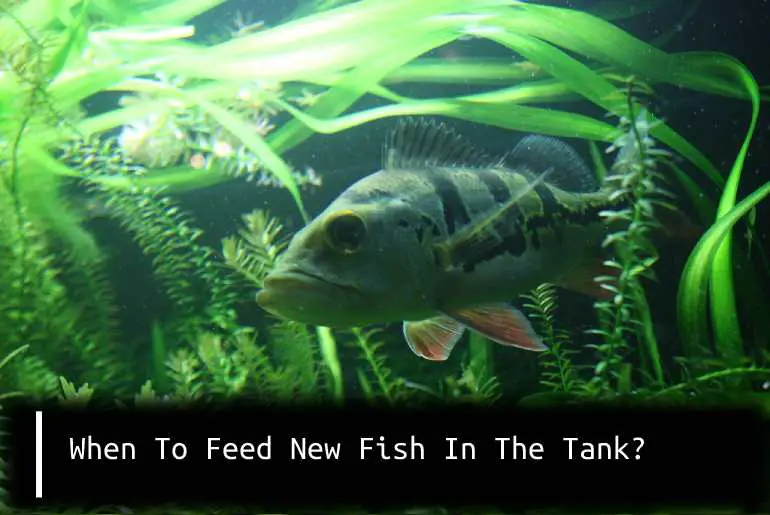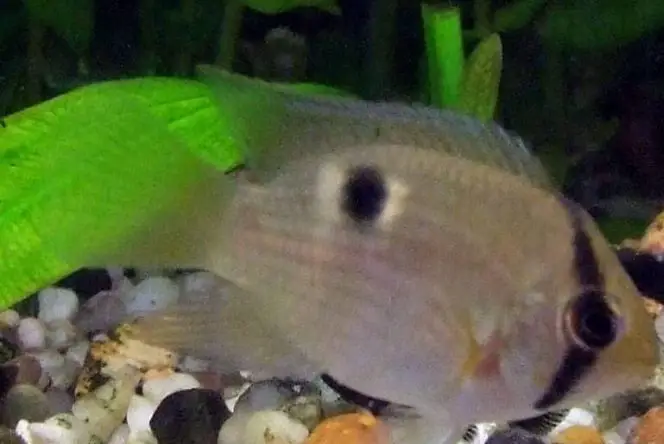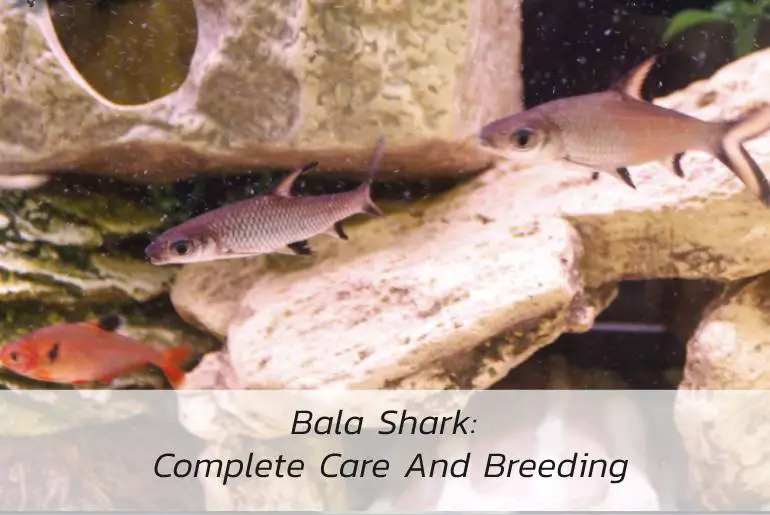It is usually really thrilling for you to bring your new fish home and put them in your aquarium. But take a minute to consider your latest acquisition. Most likely, they are worried and afraid. So, When To Feed New Fish In The Tank?
Consider the last time you were placed in an unfamiliar setting that was hectic and chaotic. I can feel your heartbeat quickening! You probably didn’t think about eating at all! When transferred, the majority of fish behave similarly. Although it is not required, the fish will let you know if you should start feeding them right away. While some fish may instantly start swimming, others could retreat and hide. If not, try again in 24 hours.
There is no science involved, and over time, just as with any pet, you will come to understand them. We will talk about when to feed new fish once you’ve put them in your aquarium in the article that follows. Along with some fascinating facts and fundamental advice, we will also discuss the interval of time you would need to wait before feeding them, the optimal time to feed them, and how many times a day you should feed them.
How Long Should You Wait Before Feeding Your New Fish?
You might have heard that you should not feed your fish straight away after putting them in a new tank if you’ve kept fish for a while. Instead, you ought to hold off on feeding them for 24 hours.
Why should you hold off for so long?
Well, the response may differ from individual to individual, and each time you ask, you could get a different explanation. This is due to the fact that there isn’t scientific evidence to back up this odd and arbitrary rule.
You could observe, though, that perhaps the new fish is reluctant to eat and is not even swimming or hiding. Any time your fish’s habitat changes, they are likely to feel anxious and even afraid. Fish require some time to get used to people and other animals before they feel at ease. You can continue feeding your new fish if you believe they have adapted well to their new environment.
Once your fish have gotten comfortable, feeding them is not an issue. However, you should usually wait a little time if you notice them hiding. Providing them considerable time before introducing them to a new tank is another thing you can do to aid when bringing new fish to a tank.
When Should You Feed Your Fish After Being Added?
It is quite likely that stress will cause your fish to delay eating. The new fish will spend some time before making friends when there are other species in the tank, and there is a possibility that it may locate an area to hide. This does not exclude you from feeding your fish before the 24-hour mark, though.
It is also conceivable that your new fish won’t adjust at all or that it may take them more than 24 hours to do so. Once you get them inside the tank, you may give them a small amount of food, and if they do not appear interested, you can just leave them alone for a bit. Eventually, your fish will become hungry and require food. A general guideline is to let your fish 24 hours to adjust and have enough time to get hungry.
Having said that, you may start feeding your fish right away if you notice that they are energetic, swimming about, and otherwise seem normal. So, the answer to the question of when to feed new fish depends more on the health and acclimatization of your fish.
What Time Of Day Is Best To Feed Fish?
It is always ideal to follow a schedule, regardless of the time you choose. Your fish will begin to gain an understanding of time and get ecstatic as you approach the aquarium in anticipation of feeding them.
Below, I will go through some of the most typical occasions to feed your fish. But in my perspective, morning and evening are the optimum times to feed the fish.
When trying to feed a new fish that has recently been brought to the tank, though, you could discover that it has not yet formed a link with other fish and might not eat at the same time as your other fish.
Feed your senior fish in a different area of the aquarium if this occurs. You may attempt to feed and draw forth your new fish in another area of the tank after they have all relocated to that one.
Let’s briefly go through when to feed your fish most frequently;
Morning
The ideal time to feed your fish is generally in the morning. Mornings are often the best time to feed fish if you just feed them once a day. The earlier you eat in the morning, the better off your fish will be all day since they are active. This would not be a good idea, though, if the tank contained nocturnal fish.
Afternoon
Even while it is not always a bad idea, feeding fish in the afternoons is not advised. Try to feed in the morning or the evening if you just feed once a day. The afternoon is ideal if you decide to feed these fishes more than once a day.
Evening
It is okay if you decide to feed your fish mostly in the evening, but try to make sure you do it a bit sooner. With the exception of nocturnal fish, the majority of fish enter a rest mode at night, which results in decreased activity and metabolism. It is advised to feed them prior to beginning to relax in order to avoid interfering with their metabolic processes. Nocturnal fish can be fed at any time during the night.
Feeding Fish Food
The majority of fish commonly found in aquarium stores, particularly those suggested for beginners, can survive on processed (flake, stick, or pellet) diets. Some fish can even live on it, but, like other creatures, fish normally benefit from a varied diet.
Why
Food for fish is a little delicate. The nutritious content of your fish’s diet can be harmed by subjecting it to sunshine, having the cover off so that moisture can enter, or purchasing a very large jar that will take eight months to empty.
What
In general, there are five categories of fish food:
- A variety of processed food (flakes made from processed ground stuff, pellets often divided into categories for omnivorous, vegetarian, and carnivorous fish).
- Foods that have been frozen-dried (whole beasties such as blood worms, daphnia, etc.)
- Items that have been frozen (more whole beasties).
- Live food (live beasties).
- Other fresh meals (homemade Beefheart for carnivores, zucchini for your pleco, etc.)
Some of the best choices are:
- Omega one pellets
- Ocean Nutrition Instant Baby Brine Shrimp 0.7-Ounces (20 Grams) Jar
- Omega One Freeze-Dried Blood Worms, 0.96 oz
- 200 Live Daphnia by Aqua L’amour
- Hikari Bio-Pure Freeze Dried Daphnia for Pets, 0.42-Ounce
- Hikari Tubifex Worms Fish Food (0.7 oz.) [Set of 2]
Many fish keepers compare flake food to rice. It will work for the majority of meals, but occasionally adding a little bit different is crucial. The maxim “feed your fish just what they can eat in 3 minutes” or a similar platitude will be heard by almost every novice fish keeper. The novice finds this alarming because the fish are plainly voracious. What if they went hungry? Just a small pinch here! How can that be sufficient?
Steps To Feed New Fish In The Fish Tank
- Treat it with respect.
- We anticipate that most people keep fish so they can observe them. If not directly, then at the very least broadly. When you eat is the ideal moment to do part of your observation.
- Place yourself close to the tank to observe every time you feed. Don’t put in as much as you believe is necessary.
- Observe the fish eating it.
- Keep an eye on what sinks to the bottom.
- Take the time to find out whether any of your other fish will scrape the bottom if you don’t have any fish that are predominantly bottom feeders (such as plecos, corydoras, loaches, etc.); gouramis frequently will, but rainbows typically won’t, for example.
- You can find this in detail in our other article.
How Frequently Should I Feed My Fish?
The sort of species you have mostly determines how frequently you should feed it. However, it is customary to feed your fish at least once every day. Having said that, you might need to feed a certain kind of fish more than once per day if it has a more varied diet, is a specific size, or is particularly active.
Okay, now that you are aware of the norm, let’s talk about the most normal feeding intervals for fish.
Several Times Every Day
You must comprehend your fish’s activity level and metabolism if you intend to feed it several times every day. Fish that prefer to move slowly, hide, and rest may get more hungry than fish that are extremely active in the tank.
For instance, the majority of African Cichlids would probably require feeding more than once every day. The metabolism of fish is another element that modifies their nutrition. Fish from warmer regions often have greater metabolisms and eat more frequently.
Always be mindful of overfeeding if you eat more than once a day. By observing how rapidly the food is being devoured, you may determine whether you are overfeeding your fish. If it takes more than 5 min, you are probably feeding individuals more than they require.
Once Each Day
The most common method is to feed fish once every day. Fish are excellent energy savers. With just one feeding, they can easily get through the day.
Nevertheless, the amount being given should be sufficient to provide them with enough energy to last the entire day. The majority of fish do not require feeding several times daily. Even with only one meal each day, they will follow their habits and remain happy and healthy.
Every Week
Only some fish species are subject to the weekly feeding rule. These are often sluggish fish that spend most of their lives partially hibernating. In any event, feeding all fish more regularly than once per week is typically advised.
Fish, however, may survive without food for an extended time before they become malnourished. When you only feed them once a week, you can give them a lot, increasing their chances of survival. But you should not do this on a regular basis.
You must feed your fish at minimum once a day if you enjoy watching them swim and play. There are other feeding techniques where individuals let their fish fast one or two days a week. This aids in their digestion, but for the remainder of the week, the fish should still be fed at least once daily.
Are Your New Fish Sluggish to Eat? Next, what?
You have not seen your new fish in two to three days, and you are beginning to worry. Can you locate your fish? Is it tucked up in a dim place? Do other fish bother it at all?
These are a few of the questions you should strive to answer. When I initially put a fish in the tank, he was really timid, and I once had one like that. I went looking for him because I had not seen him in days.
One piece of advice was to purchase a tiny mirror and use it to peer down the aquarium’s wall-facing side. I was fortunate enough to see his tail protruding from a crack in the living rock. Now that he was moving, I moved on to step #2.
I waited until my aquarium’s lights went off, then returned downstairs with a red-lens flashlight approximately an hour later. You may observe the aquarium’s residents without disturbing them, thanks to this. The other fish were sleeping when I discovered the new fish swimming about. This could apply to your new fish. Particularly the fish that are really bashful or the fish that are loud or possessive.
Whenever it was swimming about at night, I occasionally sprinkled in just a few pellets for it, and after about 10 days, he began to show himself during the day.
What To Do If He Is Not Showing Or Swimming Out?
If your fish are swimming about but not eating, you might want to consider the following:
- Try a new food: You never know what fish will appreciate. Try freeze-dried, Mysis, or frozen products.
- Make a call to the shop where you purchased the fish to find out what they usually feed their fish.
- Ideally, you have already done your homework and are aware of any dietary requirements for the fish. It is well known that Copperband Butterflyfish and Mandarin Dragonets will start eating your food.
- Consider feeding your pet at varying times of the day.
- Try using a feeding pipette or syringe to dispense food very next to the fish.
- The fish should be caught, put in a breeder cage or isolation box, and then given food so they may eat without being bothered by other fish.
Why Are Fish Quarantines The Best Method?
If you are new to saltwater tanks, you may have heard the term “quarantine,” which conjures up pictures of sick people being kept apart in developing nations.
Fish fall within the same category. A separate aquarium called quarantine can be put up at any moment or run continuously.
Points To Be Aware Of Fish In New Tank
The majority of people probably think, “Great, another aquarium to maintain!” But I’d like to tell you a few points you might not be aware of.
- A modest 5-gallon tank that can be put up at under $50 can serve as a quarantine tank.
- If you ‘Seed’ the filter sponges in your aquarium, it can be prepared to go at a moment’s notice if you have got a sick or new fish.
- Each new fish you buy should spend at least four weeks in quarantine.
- The fish are given time to recover from transit during this period.
- Enables you to get the fish to eat without interference.
- Enables a fish to strengthen itself if it was previously housed in a poor aquarium.
- Allows you to treat sickness, fungus, and parasites both inside and externally.
- Prevents ‘Tank-Decimating’ diseases like Velvet & Ich from entering your primary aquarium.
Simply said, the tank does not need to have any lights or sand. You only need a sponge filter, a heater, a thermometer, and some PVC pipe fittings for shelter. When your fish reach your display tank, they will be healthy, happy, and robust to enjoy a new lifestyle in your glass box. If you keep them there for four weeks after purchasing them, they will truly grow in leaps and bounds.
FAQ
Should I Feed My New Fish?
Rocks, bushes, and other objects make an excellent cover, reducing stress on your fish. Before introducing new fish to your aquarium, feed the existing fish. The present fish will become less hostile as a result. Turn off the lights in your aquarium before introducing your new fish.
How Can I Tell If My New Tank Is Fish-Ready?
Before introducing new fish, wait until the levels of nitrite and ammonia have reached zero. Only a few fish should be added each week while a new aquarium is going through all the initial nitrogen cycling, which typically takes 3-6 weeks.
How Long Does It Take New Fish To Adjust?
The majority of individuals will advise you that this usually takes fish around 15 minutes to get used to an aquarium. While this is largely accurate, it takes a new fish a minimum of one hour to fully adapt to its surroundings.
Why Is It Necessary To Wait 24 Hours Before Adding Fish To A Tank?
The chemicals will take roughly a day to remove chlorine and bacteria and restore ammonia and nitrate levels to safe levels for fish to survive in. Before starting a 24-hour timer, test the water once, then again before adding fish.
Conclusion
If your new fish are focusing on getting food, they will let you know right away. They will typically consume a modest bit of food if they are on their own within the first hour.
Start giving your fish at least 24 hours to come out of hiding before attempting to feed them. Whether these fishes are your first fishes and they aren’t eating, make sure to remove any leftovers to keep the water from becoming contaminated. For eliminating said food, a gravel vacuum or a turkey baster are excellent instruments.
Usually, aggressive or restless behavior in fish is a sign of hunger. Fish discarding the food is another indication that they don’t need anymore to survive.
Your fish will eventually develop the necessary confidence, and once they do, they’ll swim around constantly.






